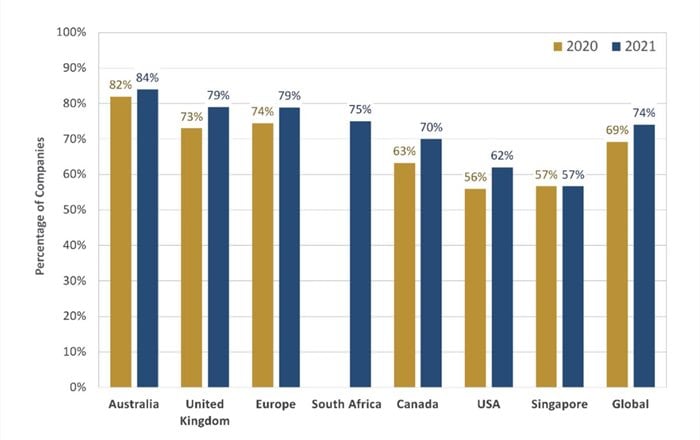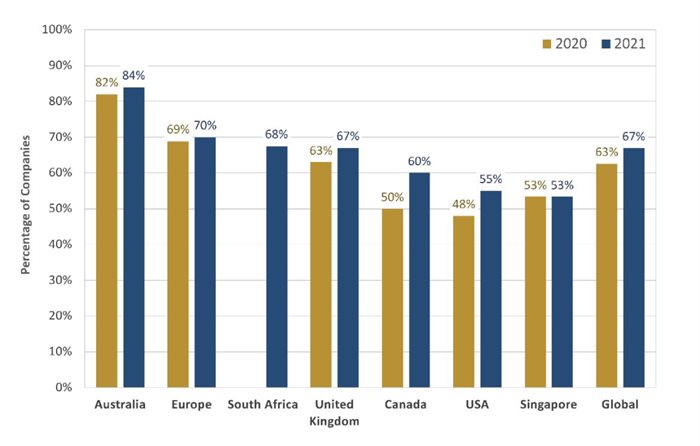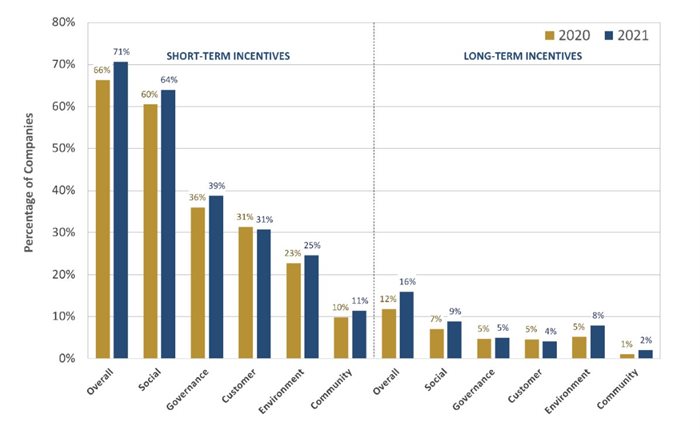
Chris Blair, CEO of 21st Century.

Figure 1: Percentage of companies using ESG metrics in incentives by region.
We have just completed the study across eight listed exchanges in which South Africa is the only emerging market exchange. South African listed companies can stand tall amongst the developed nations in our adoption and application of ESG metrics.
ESG metrics can be described as non-financial metrics and are about the sustainability of the world, the continents, countries, businesses and society. Society is becoming more vocal about government and business practice as the world moves from “Shareholderism” to “Stakeholderism”.
This trend has been catapulted forward due to the Covid-19 pandemic, which has highlighted the unsustainable business practices worldwide that are leading to the destruction of the environment and of society.
Janavi da Silva 24 Dec 2021 This year’s GECN research aimed at examining any year-on-year trends in companies using ESG metrics in executive incentive plans (both the prevalence and weighting), particularly changes in connection with the Covid-19 pandemic and the increasing market pressure for companies to increase their focus on ESG in their business strategies.
Our study also identified that a growing number of companies are starting to incorporate ESG metrics in executive long-term incentive plans and that the weighting is higher than in prior years - tying sustainable metrics to executive pay in the long term.
The main trends emerging from the study are as follows:
- A growing number of companies across the world are tying executive pay to ESG performance, particularly in the environmental area in long-term incentive plans.
- There is an increase in the number of companies using Social Metrics in their incentives in all regions, except Singapore.
- Companies allocate a higher weighting to ESG metrics in short-term incentives (25%) than in long-term incentives (20%).
- The global average aggregate weighting of ESG metrics in incentive plans account for 9% of the maximum total remuneration package (fixed pay plus variable pay) received by the company’s top executive each year.
More than 74% of companies in all sectors reviewed use ESG metrics. South Africa ranks 4th in the world with 75% of companies using ESG metrics, whilst Australia leads (84%), followed by Continental Europe (79%).

Figure 2: Percentage of companies using social metrics in incentives by region.
There has been a huge swing towards Social Metrics, catalysed by the pandemic which highlighted the inequity of pay and wealth around the world, particularly prevalent in South Africa, which has the highest Gini coefficient (measure of income inequality), and one of the highest unemployment rates in the world. South Africa moves to 3rd place for the use of Social Metrics (68%), behind Australia (84%) and Europe (70%).

Figure 3: Average proportion of top executives’ maximum total remuneration contingent on weighted scorecard ESG metrics by region.
South Africa ties in 1st place with Australia, with 13% for the most important metric of ESG – the weighting of the executive maximum total remuneration linked to ESG metrics. The link between the executive key performance indicator (KPI) and executive pay is critical in incentivising the executive to “do the right thing”.

Figure 4: Percentage of companies using ESG metrics in incentives by short (left-hand column) and long-term (right-hand column) incentives by type of measure.
Figure 4 shows that using ESG metrics is much more prevalent in short-term incentives (71%) than in long-term incentives (only 16%). We can only hope that the move from short-term towards long-term incentives continues rapidly, as this is how ESG metrics will become sustainable.

Figure 5: Weighting of ESG metrics in incentives by short and long-term incentives.
The prevalence does not, however, tell the full picture of the effectiveness of ESG metrics in short- and long-term incentives. It is rather the weighting of the metric that is important, as this incentivises the executive’s behaviour. The median weighting for ESG metrics in short-term incentives is 25% compared to 20% in long-term plans, and is significant for both.
The upper quartile, 25% of metrics or more have a weighting in short-term incentives of 40% and 30% for long-term incentives. This is encouraging for the future sustainability of ESG. Even at the lower quartile, 25% of metrics or less still have a weighting of 20% for long-term incentives.
The world is in urgent need of change in terms of its environment, climate change, social inequity and well-being. ESG metrics could be the silver bullet that brings this change about, but only if it is universally adopted and governed. South Africa sets an example that as an emerging market, we can contribute and stand tall amongst our world peers.



































